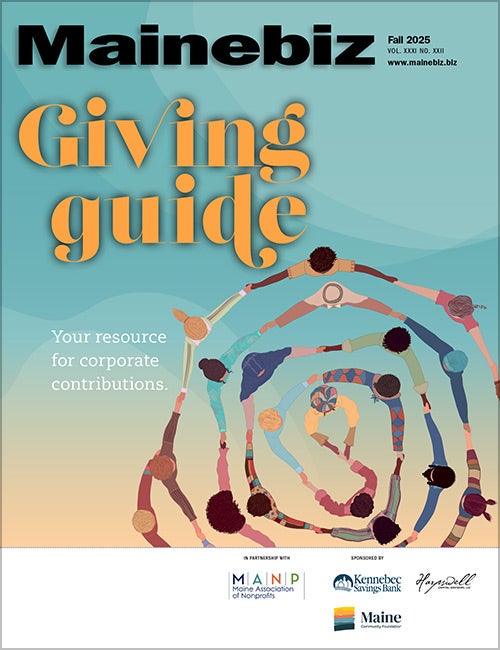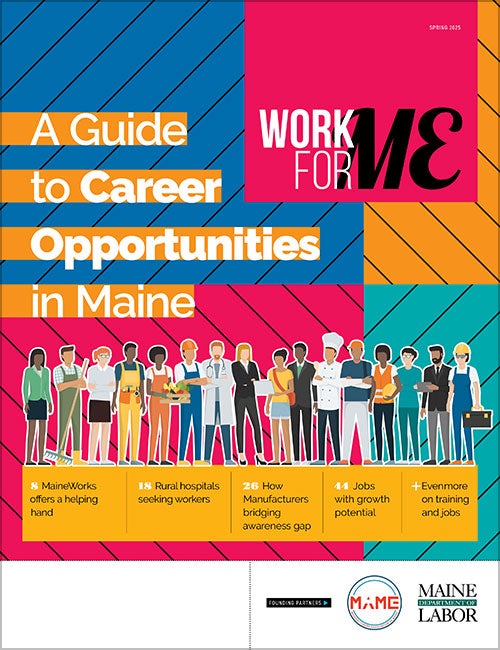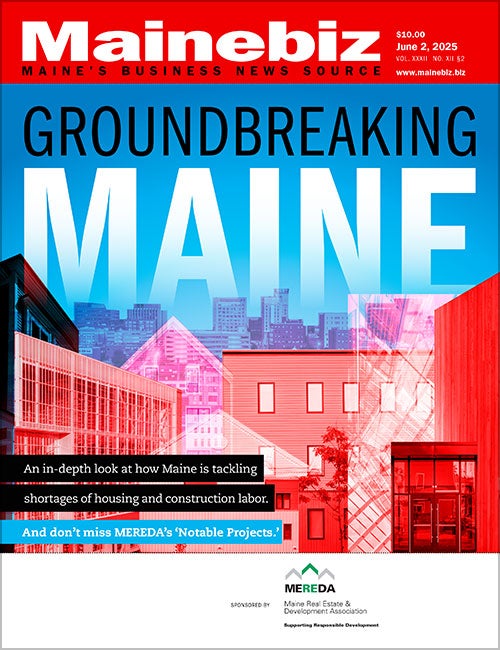Processing Your Payment
Please do not leave this page until complete. This can take a few moments.
- News
-
Editions
View Digital Editions
Biweekly Issues
- December 1, 2025
- Nov. 17, 2025
- November 03, 2025
- October 20, 2025
- October 6, 2025
- September 22, 2025
- + More
Special Editions
- Lists
- Viewpoints
-
Our Events
Event Info
Award Honorees
- Calendar
- Biz Marketplace
Banking on women | New efforts at KeyBank and beyond aim to better serve women business owners
But when they finished their breakfast, they kept talking. They chatted with one another, with representatives from the SBA and Wiscasset-based Coastal Enterprises Inc., and with members of the Service Corps of Retired Executives well after the official end of the program.
The women were "hungry for the opportunity to network with other women," according to Terry Trickey, vice president and relationship manager for small business at the Maine district of KeyBank N.A., which sponsored the January event as the kickoff to a new effort by Key to reach women business owners.
The company recently formalized its outreach to women business owners by pulling together a team of female bankers, led by Trickey, to specialize in serving them. The effort is part of Key4Women, the Cleveland-based bank's six-year-old national program to serve what the company sees as a lucrative market that is in need of special attention. "The research shows that 86% of women entrepreneurs prefer to do all their banking in one place," says Kathy Underwood, president of Key's Maine district, referring to a recent study by the Washington, D.C.-based Center for Women's Business Research. By combining business banking, financial planning and personal banking services, Underwood believes Key can attract new customers and better retain its existing women business owner clients.
Women-owned businesses make up the fastest growing sector of the U.S. economy, according to the CWBR. As a result, financial institutions in Maine and nationwide are taking a closer look at the potential for growth in various methods of appealing to women business owners. However, while there is little doubt that women are a key market segment, there is still some question as to whether KeyBank's marketing style is the right approach.
Marketing for women can be a "complex and subtle" task, according to Mary Brown, president of Imago Creative, a Portland strategic marketing and design firm that specializes in helping companies build brand relationships with women 35 and older. "Overt 'for women' marketing efforts are sometimes a turn-off to women," says Brown.
She feels that a woman "doesn't always want special 'women treatment,' she just wants to know she's being listened to and that marketers understand her reality. A more transparent marketing approach that focuses on what's actually important to her as a business woman will be more effective in the long run."
Outside the old boys' network
According to the CWBR, the growth rate of women-owned firms is twice that of all firms (17% and nine percent, respectively), and women-owned firms with employees grew at three times the rate of all firms with employees between 1997 and 2004. However, women continue to face many of the same business challenges they faced before this recent growth trend.
Among those challenges is a lack of access to the established network of capital lenders and investors. Banks, women's organizations and research institutes alike report that women entrepreneurs are continually working to break into the "old boys' network" that could help them realize their capital needs earlier in their business plans. In 2000, a report entitled "Women Entrepreneurs in the Equity Capital Markets: The New Frontier," conducted by the CWBR and sponsored by Wells Fargo, said that "a primary factor to success in the equity capital arena is gaining access to the right networks of business advisors." In addition, "two-thirds of the proposals that are seriously considered by institutional investors come from these referral networks."
This lack of access and visibility often forces women to pare down their efforts. "Most [women-owned businesses] start on a smaller scale and often pursue a service business with lower entry costs [because of the] lack of funding sources," says Marilyn M. Helms, a professor of management at Dalton State College in Decatur, Ga. Helms says women typically rely on funding from family loans, retirement or savings accounts, or expensive credit card debt to fund their startups.
Women entrepreneurs also seek less credit than their male counterparts. According to the CWBR, women business owners are 21% less likely to use commercial credit than male business owners.
This puts women at a disadvantage in seeking other sources of credit; because they seek lower amounts, their requests may not be as attractive to financial institutions as larger requests might be. Trickey notes that women "haven't been as exposed to conventional commercial financing" as their male counterparts have.
When they do seek capital or credit, women often are challenged to present nontraditional businesses in ways that make sense to bankers and investors who are used to more traditional investment opportunities. "Bankers in general may be less familiar with the type of businesses ˆ crafts, decorating, restaurants and other services ˆ women are interested in," says Helms.
Jim Donnelly, regional vice president for Machias Savings Bank, agrees that it is often a challenge for women to find enough collateral to start a nontraditional business. "Some of them have to educate their banks on why this business makes sense," he says.
In the past year, Machias Savings has targeted its mentoring efforts toward women-owned businesses. It would seem to be a wise approach; a recent survey of 404 women CEOs, business owners and executives by the Commonwealth Institute, a Boston-based peer mentoring group, cited a lack of mentors as the greatest obstacle to women entrepreneurs. Eighty-seven percent of respondents said they would have advanced more quickly in their careers if they had a mentor along the way.
Donnelly says the bank is "working on significant networking opportunities with our women business owners that we'll be announcing in the coming months. These would be chances for women to get together, talk about the unique challenges they may face, bounce some ideas off one another and maybe have a little fun at the same time."
A re-branding initiative
By specifically highlighting what KeyBank executives describe as women business owners' "unique challenges," the firm hopes to address both the issue of access to capital and the need for stronger professional networks.
"Women are more consultative in their decision making," says Underwood, noting that 41% of women business owners will look to an external financial advisor, according to a 2004 report by the CWBR. "When they consult, they want to talk to other women."
Thus, the formation of the Maine team ˆ Trickey, as well as Tracey Russell, a vice president and financial advisor with McDonald Financial Group; Teresa Thompson, a vice president and manager of Key's Scarborough office; and Jean O'Donnell, a vice president and manager of a South Portland Key branch. "We work well together as a teamˆ we bring different expertise to the tableˆ [so we can] nurture and manage relationships with our clients," says Trickey, adding that the new initiative offers female business owners "one place where they can have a relationship and have their banking needs met."
"The culture of Key has always been a collaborative one, which allows us to do what is best for our clients," says Underwood. The women at Key had worked together informally in the past; now, they've simply formalized the arrangement to include a focus on women business owners. They each work in different offices, and will continue to work with clients both male and female. Now, though, the team will meet once a month to "talk with each other about our clients or prospective clients," said Trickey, "and we go on joint calls to meet with business owners together."
Underwood adds that "all clients work with a team that can bring appropriate financial solutions to the relationship. The Key4Women initiative allows our team to focus specifically on the needs of women business owners and, based on our research, respond to what will benefit their business the most." Marketing efforts for the new initiative are still in the works, according to Underwood.
The January meeting on SBA loans was the first of what will be quarterly roundtable discussions that serve as education and training tools, as well as an opportunity for professional support and networking. "The response has been overwhelming," said Underwood. "The participants were so enthusiastic."
In many ways, the Key4Women initiative is simply a case of re-branding many of the company's existing policies. For example, Key has a long-standing company-wide goal of doing more business with women-owned vendors and suppliers; through Key4Women, it hopes to heighten awareness of the goal. The company also has promised $1 billion in loans to women business owners throughout its 13 state franchise over the next three years. (When asked how this commitment compares to previous lending to women business owners, Underwood said these numbers haven't been tracked in the past.)
Hannah Gregory, owner and managing director of Shoestring Creative Group, a marketing firm in Portland, sees wisdom in KeyBank's marketing choices. The Key4Women initiative "seems to be an example of 'cause marketing,' where they are not necessarily doing anything new themselves, but [they are] supporting ˆ financially and in-kind by shedding additional attention on ˆ programs that are already in existence," she says. "They are aligning themselves with the 'cause' of women-owned businesses."
Gregory adds that the concept works "as long as they don't make the assumption that because we are women we need additional help."
According to Underwood, some banks across the country are targeting women business owners much more aggressively. "There are banks out west with entire entrances designed for women business owners," she says. It is unclear, though, how well these marketing efforts are doing at actually attracting clients.
The market of one
Other financial institutions have avoided reaching out to a specific group or segment, feeling that their individual attention to customers is their best marketing approach. Lorraine Boston, executive vice president of commercial lending with Kennebunk Savings Bank, sees her bank's market as the entire York County community ˆ and each potential customer in it. Rather than targeting women-owned businesses, she says the bank takes into account the capital needs of all business owners through what she describes as a "personal, individual approach ˆ we address each business owner's unique needs, whether they're male or female."
Donnelly of Machias Savings Bank concurs, saying that small businesses often seek a very direct relationship, with the bank "playing the role of mentor or partner for those owners."
Boston says Kennebunk Savings supports training for business owners via a partnership with York County Community College's Center for Entrepreneurship, and it addresses needs specific to women through community collaborations such as a recent conference called "Money Matters for Women of All Ages." Kennebunk Savings partnered with United Way of York County, the Virginia Hodgkins Somers Foundation and the Federal Reserve Bank of Boston to fund the event, which drew more than 170 attendees. The bank also regularly supports networking events throughout York County to help business owners meet and overcome some of the universal challenges they face.
That's a topic with which Judy Morin is familiar. Morin, the vice president of administration at Biddeford-based Ocean Communities Federal Credit Union's Sanford branch, recently helped her organization expand into commercial lending for the first time. In that process, Morin says, the credit union faced the same challenges "that anybody would face. I don't know of any that are specific to women" she says. "It's all around establishing yourself, establishing your credibility, providing value through the service and products that you offer, and attracting help and staffing that can support your new business' mission."
At KeyBank, in the months ahead Trickey and her team plan to rely on feedback from women business owners who already are clients or who attend the roundtable discussions in order to shape the program's direction. Already, attendees have asked for more chances to get together, requesting that the roundtable events be held monthly, rather than quarterly. "As our mailing list grows, I'd like to see us targeting specific industries" for the roundtable discussions, says Trickey, "so we can reach more people, but make sure everyone gets value out of it."
Better serving those customers is essential if the program is to work, according to Brown of Imago Creative. "I believe KeyBank's Key4Women program is built on good intentions, but the carry-over into actually reaching and helping women business owners is poor in the state of Maine," she says. "If you are going to brand a program for women, you've got to deliver useful, unbiased solutions or women will get suspicious that you are trying to patronize them for the sake of getting business."
When asked about the possibility that some women might object to this kind of marketing, Underwood replies, "Based on the response that we've had, I'm surprised that that would be the case ˆ the research indicates that women need access to additional networks and opportunities, and that women business owners are open to accepting advice and support to help them succeed."
Shaking the tree
ˆ Nationally, women-owned businesses employ 19.1 million people and generate $2.5 trillion in sales. In Maine, these businesses employ 75,214 people and generate $9.0 billion in sales.
ˆ Between 1997 and 2004, it is estimated that the number of women-owned businesses in Maine increased by 16.6%. Employment in those businesses grew by 19.6%, and sales increased by 36.6%.
ˆ The number of women-owned businesses with employees nationwide has expanded by an estimated 28% between 1997 and 2004, three times the growth rate of all businesses with employees. The number of these businesses in Maine grew by 18.7% from 1997 to 2004.
ˆ Between 1997 and 2004, women-owned businesses diversified into all industries, with the fastest growth in construction (30% growth); transportation, communications and public utilities (28% growth); and agricultural services (24% growth).
ˆ Women-owned businesses nationwide will spend an estimated $546 billion annually on salaries and benefits ($492 billion on salaries and $54 billion for employee benefits such as heath, retirement and insurance).
ˆ Women-owned businesses are just as financially strong and creditworthy as the average U.S. firm, with similar performance on bill payment and similar levels of credit risk, and are just as likely to remain in business.
ˆ Women are more likely to receive capital from individual investors (73%) than venture capital businesses (15%).
ˆ Women-owned businesses with $1 million or more in revenues are as likely as their male counterparts to use business earnings and bootstrapping techniques to finance their businesses, but are less likely to use commercial credit (56% vs. 71%) or equity (4% vs. 11%).
Source: Center for Women's Business Research
Mainebiz web partners

The Giving Guide
The Giving Guide helps nonprofits have the opportunity to showcase and differentiate their organizations so that businesses better understand how they can contribute to a nonprofit’s mission and work.
Learn More
Work for ME
Work for ME is a workforce development tool to help Maine’s employers target Maine’s emerging workforce. Work for ME highlights each industry, its impact on Maine’s economy, the jobs available to entry-level workers, the training and education needed to get a career started.
Learn More
Groundbreaking Maine
Whether you’re a developer, financer, architect, or industry enthusiast, Groundbreaking Maine is crafted to be your go-to source for valuable insights in Maine’s real estate and construction community.
Learn more-
The Giving Guide
The Giving Guide helps nonprofits have the opportunity to showcase and differentiate their organizations so that businesses better understand how they can contribute to a nonprofit’s mission and work.
-
Work for ME
Work for ME is a workforce development tool to help Maine’s employers target Maine’s emerging workforce. Work for ME highlights each industry, its impact on Maine’s economy, the jobs available to entry-level workers, the training and education needed to get a career started.
-
Groundbreaking Maine
Whether you’re a developer, financer, architect, or industry enthusiast, Groundbreaking Maine is crafted to be your go-to source for valuable insights in Maine’s real estate and construction community.
ABOUT
NEW ENGLAND BUSINESS MEDIA SITES
No articles left
Get access now
In order to use this feature, we need some information from you. You can also login or register for a free account.
By clicking submit you are agreeing to our cookie usage and Privacy Policy
Already have an account? Login
Already have an account? Login
Want to create an account? Register
Get access now
In order to use this feature, we need some information from you. You can also login or register for a free account.
By clicking submit you are agreeing to our cookie usage and Privacy Policy
Already have an account? Login
Already have an account? Login
Want to create an account? Register







Comments